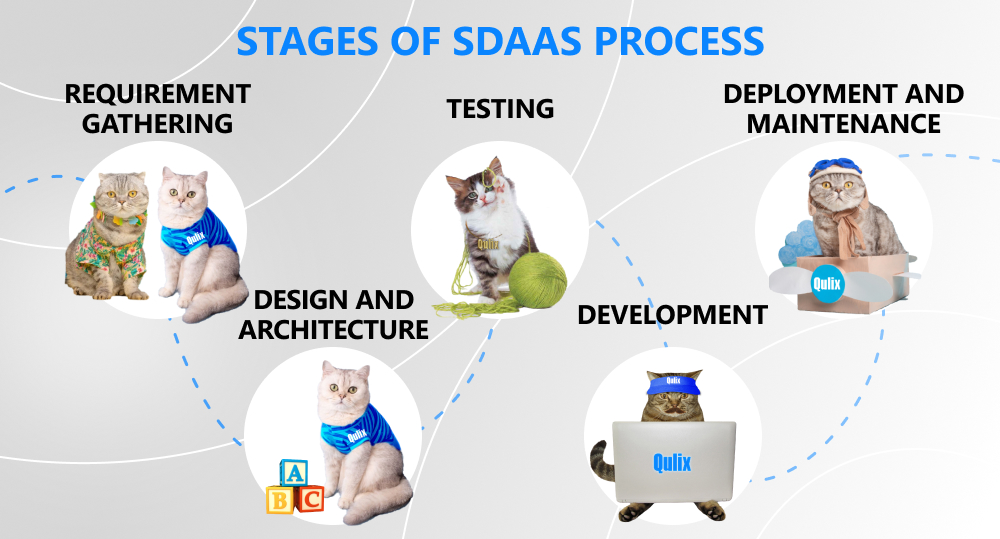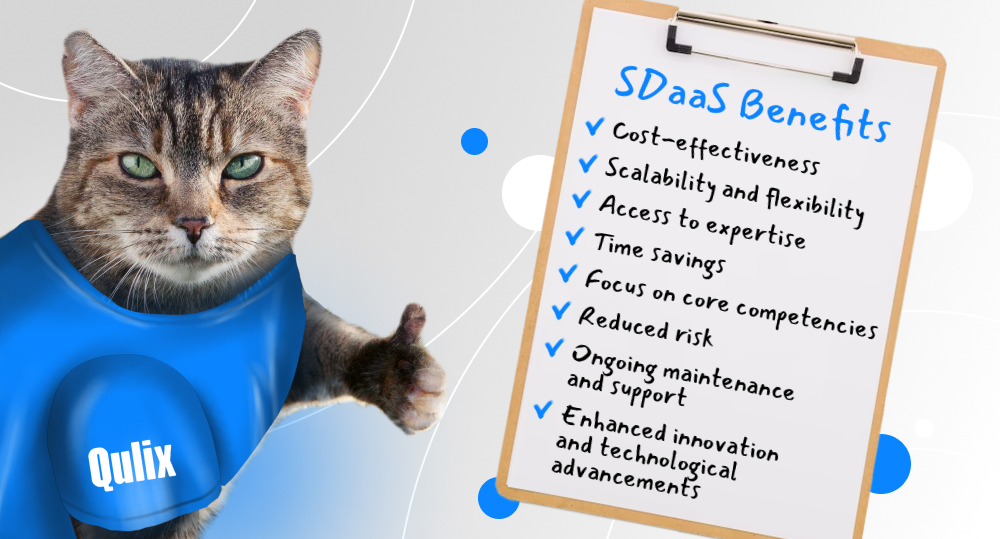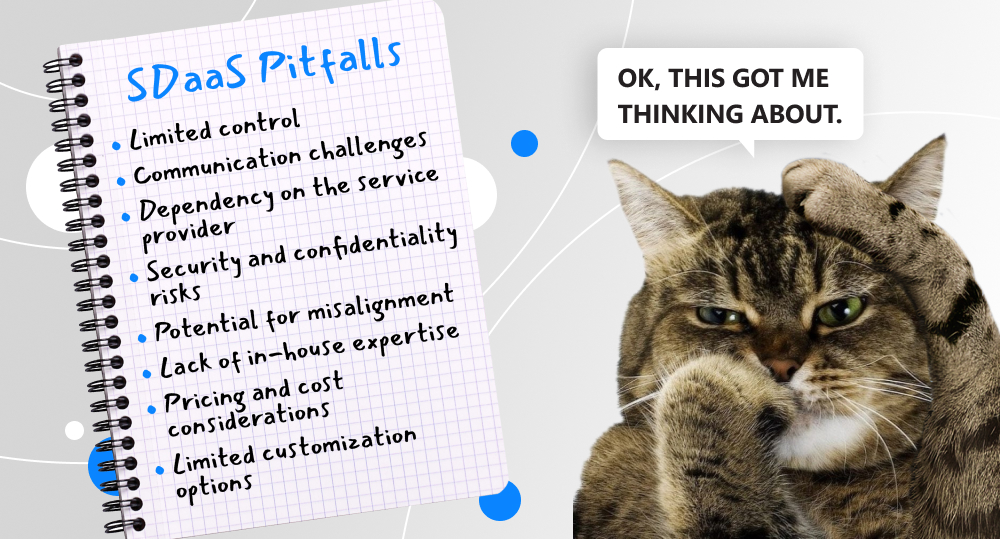Software Development as a Service (SDaaS) is a new service delivery model that is actively gaining popularity among businesses. You especially need it if you're looking for a transformative way to accelerate your software development projects while reducing costs and resource constraints. SDaaS allows you to effortlessly tap into a global pool of talented developers, access cutting-edge development platforms, and receive comprehensive support throughout your software development journey.
Let us explore SDaaS — a groundbreaking approach that is revolutionizing the way businesses bring their software ideas to life.
written by:
Anton Rykov
Product Manager
Contents
What Is Software Development as a Service (SDaaS) in 2024?
Software Development as a Service (SDaaS) is a business model where companies outsource their software development projects to external service providers. In this model, the software development company manages the entire software development lifecycle, from requirement gathering and design to coding, testing, deployment, and maintenance.
SDaaS encompasses various aspects, including:
- Application Development Platform as a Service;
- Developer as a Service;
- Software Development with Services;
- Software Development Support;
- Development Environment as a Service;
- Development Platform as a Service;
- Sales Development as a Service;
- Web Development as a Service;
- Android App Development as a Service;
- Application Development as a Service;
- Corporate Development as a Service; and
- Mobile App Development as a Service.
SDaaS is similar to other "as a Service" models like Software as a Service (SaaS), Platform as a Service (PaaS), or Infrastructure as a Service (IaaS). However, instead of delivering a ready-made software product or platform, SDaaS provides custom software development services tailored to the client's specific needs.
The process typically involves the following steps:
- Requirement gathering: The service provider works closely with the client to understand their software requirements, objectives, and business goals.
- Design and architecture: The service-based company creates a detailed software design and architecture based on the gathered requirements. This includes defining the system's structure, components, and functionalities.
- Development: The actual coding and implementation of the software are carried out by the service provider's development team. They use the chosen programming languages, frameworks, and tools to build the software.
- Testing: The developed software undergoes rigorous testing to ensure its functionality, performance, security, and usability. The company providing SDaaS services usually employs various testing techniques, including unit testing, integration testing, user acceptance testing, and others.
- Deployment and maintenance: After the software has been thoroughly tested and approved, it is ready for deployment to the client's infrastructure or cloud environment. This includes installing and configuring the solution, as well as migrating the necessary data. Once the deployment is complete, the development team may continue to provide maintenance and support services.
What Advantages Does SDaaS Offer to Businesses?
Software Development as a Service offers several benefits for companies. Here are some key advantages:
Cost-Effectiveness
SDaaS can be more cost-effective compared to establishing in-house teams. It eliminates the need for hiring and training project managers, developers, and other specialists, setting up infrastructure, and maintaining development environments. Software development companies often have standardized pricing models, allowing businesses to budget more accurately.
Scalability and Flexibility
Software Development as a Service (SDaaS) allows businesses to scale their development resources up or down based on project requirements. During peak periods or when there is a need for additional development capacity, the provider can allocate more resources. Similarly, if the project scope decreases, resources can be easily adjusted, saving software development costs.
Access to Expertise
SDaaS providers typically have experienced software developers with expertise in various programming languages, frameworks, and technologies who fulfilled multiple projects in various industries. By outsourcing software development, businesses gain access to this pool of specialized skills and knowledge without investing in training or hiring. By the way, Glassdoor calculated that the average US company spends around $4 thousand to hire a specialist, with 52 days to fill a position.
Time Savings
Outsourcing software development saves time in various ways. Service-based companies are experienced in the development process and can accelerate the project timeline. They can quickly assemble a team, leverage established workflows and development methodologies, and efficiently manage resources. This results in faster time-to-market for software products or solutions.
Focus on Core Competencies
By delegating software development to a dedicated team, businesses can focus on their core competencies and strategic initiatives. This allows companies to concentrate on activities directly related to their business needs and competitive advantage while leaving software development to experts.
Reduced Risk
SDaaS providers often have well-defined development processes, quality assurance measures, and project management practices in place. This reduces the risk of project failures, delays, or poor-quality deliverables. They also take responsibility for meeting project milestones and ensuring customer satisfaction.
Ongoing Maintenance and Support
Many SDaaS providers offer post-development support and maintenance services. This includes bug fixes, updates, and technical assistance, ensuring the software remains stable and up-to-date. Reliable support can significantly reduce the burden on internal teams and improve overall software performance.
Enhanced Innovation and Technological Advancements
Service providers stay updated with the latest trends and advancements in software development. They have exposure to a wide range of complex projects and industries, allowing them to bring innovative solutions and best practices to the table. This helps businesses leverage new technologies and stay competitive in their market.
It's important to note that while SDaaS offers many benefits, it also requires careful consideration of the service provider's reputation, expertise, and service-level agreements to ensure a successful collaboration and the desired outcomes for the business. The vendor should adequately know how to develop software as a service.
Does Software Development as a Service (SDaaS) Have Any Disadvantages?
While SDaaS offers several advantages, it also has a few potential disadvantages to consider:
Limited Control
By outsourcing software development, you may have limited control over the development cycle, methodologies, and decisions. You will need to rely on the partner's expertise and trust their ability to deliver the desired results.
Communication Challenges
Effective communication is crucial in software development. With SDaaS, there may be challenges in communication due to geographical or cultural differences, which can impact collaboration, requirement understanding, and feedback loops.
Dependency on the Service Provider
When outsourcing software development, you become dependent on the service provider for the development, maintenance, and support of your software. This dependency can present challenges if there are issues with the provider's availability, reliability, or expertise.
Security and Confidentiality Risks
Sharing your project details and sensitive information with a third-party service-based company involves inherent security and confidentiality risks. It's essential to thoroughly assess the provider's security measures and have proper legal agreements to protect your intellectual property and data.
Potential for Misalignment
Despite efforts in requirement gathering and communication, there is still a possibility of misalignment between the client's expectations and the delivered software. This could result in rework, delays, or unsatisfactory outcomes.
Lack of In-House Expertise
By relying on an external partner, you may miss out on developing in-house technical skills and knowledge. This can limit your ability to handle certain aspects of software development internally in the future.
Pricing and Cost Considerations
While SDaaS can be cost-effective, it's crucial to carefully consider the pricing structure and terms offered by the service provider. Sometimes, unexpected costs, such as change requests or additional support, may arise, impacting the overall project budget.
Limited Customization Options
While SDaaS providers offer customization, there may be limitations within the boundaries set by the provider. If your project requires highly complex or unique customizations, it may be challenging to achieve them through SDaaS.
Software Development as a Service (SDaaS) vs. Software as a Service (SaaS)
Software Development as a Service (SDaaS) and Software as a Service (SaaS) are not the same, although they are related concepts. SDaaS refers to outsourcing the entire software development process to a service provider. It encompasses the end-to-end software development lifecycle, including requirement gathering, design, coding, testing, deployment, and maintenance. The service provider is responsible for building custom software solutions tailored to the customer's needs.
On the other hand, SaaS is a software delivery model where a provider hosts and delivers a ready-made software application over the Internet to customers. In the software as a service development model, the product is centrally hosted on the provider's servers, while customers access it through a web browser or thin client. The provider is responsible for maintaining and updating the software, while customers typically pay a subscription fee to use the software.
While SDaaS involves custom software development from scratch, SaaS involves delivering an existing software application as a service. SDaaS can be seen as a service model within which the provider might deliver the software as a SaaS offering once it is developed.
Here's a table summarizing the differences between Software Development as a Service (SDaaS) and Software as a Service (SaaS):
Aspect
SDaaS
SaaS
Definition
Outsourcing software development process
Delivering ready-made software applications
Focus
Development of custom software solutions
Delivery of existing software applications
Scope
End-to-end software development lifecycle
Software usage and access by end-users
Responsibility
Full software development lifecycle
Maintenance and updates of the software
Customization
Highly customizable based on client's needs
Limited customization options within boundaries
Deployment Model
Custom-built software tailored to the client
Centralized software accessible via the internet
Ownership
Developed software is owned by the client
Provider-owned software accessed by customers
Pricing Model
Project-based, contract or agreement-based
Subscription-based fees for software usage
Resource Management
Provider manages development resources
Provider manages software infrastructure
Maintenance and Upgrades
Provider handles maintenance and updates
Provider handles maintenance and updates
Time-to-Market
Timeframe may vary based on project complexity
Rapid deployment and faster time-to-market
Examples
Custom software development firms
Web-based email services, CRM, project management
Who Needs Software Development with Services?
SDaaS can benefit a wide range of individuals and organizations. Let's have a detailed look at each category.
Startups and Small Businesses
Startups and small businesses often have limited resources, including budget and technical expertise. SDaaS can provide them with access to professional software development services without the need for significant upfront investments. It enables startups to focus on their core business activities while outsourcing their software development needs to specialized providers.
Enterprises
Large enterprises may already have in-house development teams, but they can still benefit from SDaaS in several ways. It allows them to scale their development efforts quickly during peak periods or when additional expertise is needed. SDaaS can also help enterprises tackle specific projects or develop niche applications that may require specialized knowledge or skills not readily available within the organization.
Non-Technical Companies
Companies operating in industries that are not primarily focused on technology may find it challenging to develop software in-house. SDaaS offers an opportunity for these non-technical companies to leverage external expertise and develop software solutions tailored to their specific needs. It allows them to stay competitive by incorporating technology into their business operations without diverting significant resources to build and maintain software development capabilities.
Companies with Limited IT Resources
Some companies, especially those in non-technology sectors, may have limited IT resources or lack dedicated development teams. SDaaS can be an ideal solution for such organizations as it enables them to leverage external professionals with the necessary tech stack and experience. This ensures high-quality software development without straining their internal resources. According to Clutch, 40% of small businesses can't complete their projects on time and under budget because they lack in-house expertise.
Companies Requiring Custom Software Solutions
Organizations that require custom software solutions to meet their unique business needs can benefit from SDaaS. Service providers can work closely with these companies to understand their requirements and develop tailor-made software applications. SDaaS allows for a collaborative development process, ensuring that the software aligns closely with the client's specific goals and workflows.
Companies Requiring Rapid Time-to-Market
In today's fast-paced business environment, companies often need to bring new products or services to market quickly. SDaaS can expedite the software development process through the expertise and streamlined development practices of the provider. This enables companies to reduce development time and gain a competitive advantage by launching their software solutions faster.
Companies Requiring Scalability
Businesses experiencing fluctuations in their software development needs can benefit from SDaaS's scalability. SDaaS providers can quickly allocate additional resources or adjust team sizes based on project requirements. This flexibility allows companies to scale their development efforts up or down as needed, ensuring efficient resource utilization.
Bottom Line
So, SDaaS is a new model that offers businesses access to expertise, cost-effectiveness, scalability, faster time-to-market, focus on core competencies, ongoing support, and reduced risk. These benefits make SDaaS a compelling choice for companies looking to streamline their development processes, enhance their capabilities, and achieve their software-related goals effectively.
FAQ
#1 What is Software Development as a Service?
It's a business model where companies ask a specialized vendor to create software according to their demands.
#2 What are the Benefits of Software Development as a Service?
This approach offers businesses a range of benefits, including cost-effectiveness, access to a vast pool of specialists, scalability and flexibility, enhanced innovation and technological advancements, ongoing software development support, reduced risks, etc.
#3 Is Software Development the Same as SaaS?
No, they're not the same. SDaaS refers to creating products, whereas SaaS is a specific software delivery model where solutions are provided as a service over the Internet.
#4 How Do You Distinguish between Software as a Service and Software as a Product?
Software as a Service (SaaS) is a cloud-based model where software is accessed and used over the Internet as a service, while Software as a Product refers to software installed locally and owned by the customer.
#5 What Does the Acronym SDaaS Stand for?
It stands for Software Development as a Service.

Contacts
Feel free to get in touch with us! Use this contact form for an ASAP response.
Call us at +44 151 528 8015
E-mail us at request@qulix.com











